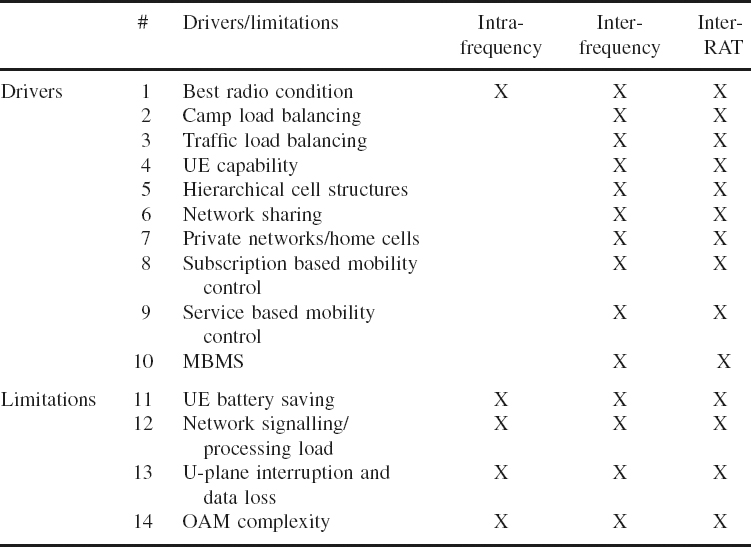Drivers and Limitations for Mobility Control
Table 13.1 the driver and limitations for handover decisions, in addition to their applicability for different mobility scenarios. Drivers form the operational basis upon which a handover decisions should be made, while limitations indicate to aspects that may constrain the selection of the handover type or scenario. For LTE, 3GPP distinguishes between three types of mobility scenarios. The first, intra-frequency, is the fundamental handover scenario and is strictly driven by “best radio condition” driver—no other driver can result in an intra-frequency handover as it will definitely result in a degrading performance. Inter-frequency, on the other hand, becomes possible when an operator has simultaneous access to multiple carriers or bands for LTE. This accessibility can be either fixed or temporary. The resulting flexibility allows for different decisions in resource control and architecture, that is, dedicate certain bands for certain services, or establish a network hierarchy. Similarly, the various drivers and limitations can be applied if the operator (or user) has access to multiple RATs.
Table 13.1 LTE handover drivers and limitations, and applicability to mobility scenarios. Reproduced by permission of © 2010 3GPP. Further use is strictly prohibited

As aforementioned, the “best radio condition” driver supersedes any other driver for handover decisions. This is achieved through cell reselection, and the standard provides—where possible—sufficient measures in terms of signaling, operations and measurements to maintain this driver's objective. For handovers to different frequencies or RATs, the UE should be provided sufficient opportunity to verify handover viability.
The remaining drivers address various needs for handovers that may arise for network operation. For example, load balancing idle or connected UEs between different bands or RATs may be possible, depending on UE capabilities. The UE capability driver is a generic driver, allowing for supporting opportune overlay and UE capabilities combinations. The driver “private networks/home cells” enables users with accessible HeNBs, that is, either the user is in the CSG or the HeNB is open, to handover when possible. Care, however, should be taken with such driver to avoid unnecessary handoffs.
Handover limitations including UE's battery, signaling and processing overload, U-plane interruption and loss possibilities, and OAM complexity. These limitations ensure that handover decisions do not result in the UE unjustifiably expending battery energy, nor result in excessive signaling or processing on part of the network or the UE. Also, a handover decisions that risks serious interruption to user service delivery should be avoided. Finally, all handover decisions should be made so that they do not require excessive efforts in operation, administration, or management of network resources.
Beyond describing the drivers and limitations, the standard also describes required features to support the various handover drivers and scenarios in the IDLE and ACTIVE modes, and in transitioning between. The required features are described in full for handovers made across the different 3GPP technologies (LTE, UTRAN, and GERAN.) For example, in transitioning between IDLE to ACTIVE in LTE and between LTE and UTRAN, the required features include inter-frequency/RAT measurements and measurement reporting upon RRC establishment. Supporting the “traffic load balancing” in the ACTIVE mode requires the viability of a network controlled inter-frequency/RAT handover, and exchange of load information across the different frequencies/RATs. These and other descriptions are made detailed in Annex E in 36.300.
